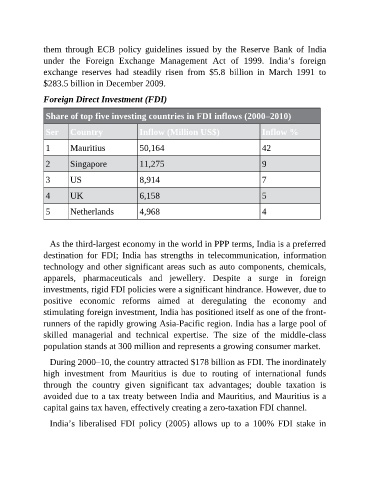Page 455 - SSB Interview: The Complete Guide, Second Edition
P. 455
them through ECB policy guidelines issued by the Reserve Bank of India
under the Foreign Exchange Management Act of 1999. India’s foreign
exchange reserves had steadily risen from $5.8 billion in March 1991 to
$283.5 billion in December 2009.
Foreign Direct Investment (FDI)
Share of top five investing countries in FDI inflows (2000–2010)
Ser Country Inflow (Million US$) Inflow %
1 Mauritius 50,164 42
2 Singapore 11,275 9
3 US 8,914 7
4 UK 6,158 5
5 Netherlands 4,968 4
As the third-largest economy in the world in PPP terms, India is a preferred
destination for FDI; India has strengths in telecommunication, information
technology and other significant areas such as auto components, chemicals,
apparels, pharmaceuticals and jewellery. Despite a surge in foreign
investments, rigid FDI policies were a significant hindrance. However, due to
positive economic reforms aimed at deregulating the economy and
stimulating foreign investment, India has positioned itself as one of the front-
runners of the rapidly growing Asia-Pacific region. India has a large pool of
skilled managerial and technical expertise. The size of the middle-class
population stands at 300 million and represents a growing consumer market.
During 2000–10, the country attracted $178 billion as FDI. The inordinately
high investment from Mauritius is due to routing of international funds
through the country given significant tax advantages; double taxation is
avoided due to a tax treaty between India and Mauritius, and Mauritius is a
capital gains tax haven, effectively creating a zero-taxation FDI channel.
India’s liberalised FDI policy (2005) allows up to a 100% FDI stake in

